Revival Revived
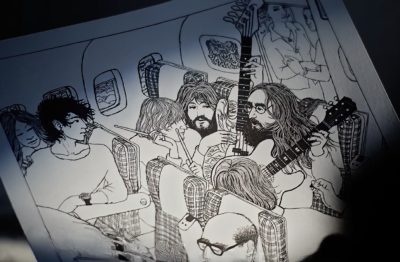
Klaus Voormann’s drawing of the 1969 plane trip
The most important musical event that ever occurred in Canada — and one of the most important concerts in history — took place at a university football stadium in downtown Toronto in 1969. It’s true!
London had The Beatles’ farewell on the rooftop, Woodstock had “breakfast in bed for 400,000,” Newport had a little issue with electricity in 1965, and Toronto saw the birth of a solo Beatle lifting off from a one-time-ever launchpad full of the founding fathers of rock ‘n’ roll.
Never before or since did Chuck Berry, Little Richard, Jerry Lee Lewis, Bo Diddley and Gene Vincent all share the same stage — and following in their footsteps in more ways than one, John Lennon took the next leap on his culture-changing path.
Lennon, McCartney & Harrison had been playing in the same band since 1958, but after years of being “more popular than Jesus,” and each evolving, by ’68 / ’69 they were starting to drift away from being a Fab Four together to four strong winds blowing in different directions.
As fate would have it — and this new Revival ’69 documentary captures — by September 1969, with their final masterpiece Abbey Road laid down in the namesake’s room, the future was wide open.
Cue: synchronicity, fate, karma, luck and happenstance meeting youthful confidence and good timing clicking in a country that had already been friendly to John & Yoko’s crusade for peace.
In June ’69, two young promoters, John Brower (22) and Ken Walker (23), booked the Toronto Pop Festival. With the geyser of popularity of pop music in the mid-’60s, a natural outgrowth of the phenomenon was to put a bunch of artists together at a ‘festival’ to attract fans of individual bands and expose them to other acts.
DJ Alan Freed was the first to start packaging multiple rock ‘n’ roll artists on the same stage as early as 1955. By ’58 he put together traveling shows with a dozen or more bands that were effectively traveling rock festivals — wonderfully portrayed in Tom Hanks’ fictional version That Thing You Do.
The first location-specific rock festival was the Fantasy Fair and Magic Mountain Music Festival held on Mount Tamalpais just north of San Francisco on June 10th & 11th, 1967, featuring 20+ bands including the Jefferson Airplane, The Doors, The Byrds, Country Joe and many others.
The festival that put the concept on the international map was of course Monterey Pop, held the following weekend in ’67, filmed by D.A. Pennebaker, and propelling artists like Jimi Hendrix, Janis Joplin and The Who into the popular mainstream.
By 1968, the festival seed had spread and started to sprout all around America, including Los Angeles, San Francisco, and perhaps most importantly the Miami Pop Festival, which was co-produced by Michael Lang who would go on to put on Woodstock the next summer.
Over the winter of ’68 into ’69, promoters (and agents) all over the continent began planning ways to do multi-act multi-day festivals in their town, and many actually did it. Seattle, Denver, Atlanta, New Orleans, Atlantic City, Harlem and lots of other cities and towns (like Woodstock) pulled them off around America; Essen (Germany), Bath (England) and the Isle of Wight happened in Europe; and both Vancouver and Toronto staged them in Canada.

Besides the stellar lineup of the June 21st/22nd Toronto Pop Festival which included The Band, Sly & The Family Stone, Blood Sweat & Tears, The Velvet Underground, Dr. John, Johnny Winter, Procol Harum etc. etc., one weird twist was Brower/Walker’s inclusion of Chuck Berry. Most of these late ’60s rock festivals shied away from booking stars from the ’50s — except for Toronto.
And not only that, but by many accounts, Chuck’s set galvanized the crowd and changed the event from a sequence of individual concerts into a collective festival. And … the promoters caught Chuck’s set! If you’ve ever worked on a festival, or even attended a festival, you know you’re not able to be fully present for every act over multiple days. But luckily for history, Brower caught the old-timer’s set on Sunday afternoon, and said in a Welcome to the Music podcast —
“Chuck was so good in June at the Pop Festival, he had 25,000 people trying to do the duck walk and falling all over each other and laughing and just loving him, and despite the fact that we had Sly & The Family Stone and The Band and Steppenwolf who all put on incredible shows, Chuck Berry stole the zeitgeist of the moment. And that was the inspiration to think, ‘If Chuck could do that, what would it be like to have all of them on the same show?’ And that was the inspiration for it. And how about this cosmic giggle — that all of those guys were available on the same Saturday! That was a confirmation that we were on the right track.”

Problem was, concert-goers flocked to the two-day current-superstar-rich Pop Festival in June, but a ’50s show in September after schools were back in full swing was a whole different thing. Tickets were $6 — for the mathematically challenged, that’s about 50 cents a band! — but only 2,000 had sold in a stadium that held 20,000.
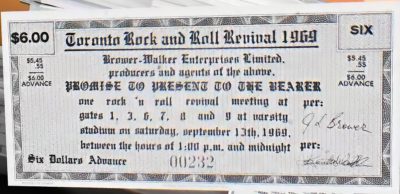
In a late attempt to be more current, the promoters added The Doors, and brought in two colorful scenesters form L.A. (where Brower had spent some time in ’67), Kim Fowley and ‘The Mayor of Sunset Strip’ Rodney Bingenheimer. But even that didn’t work. However, it did spark something that would.
With the show on the verge of being cancelled, it was the prankster hypester Kim Fowley who badgered Brower (or, “preached” to him, as the promoter recalls it) into calling Apple in London to invite John Lennon, knowing the walrus loved Chuck Berry and Little Richard, who The Beatles opened for in England and Hamberg and where he taught them the high screaming “ooouuuu” vocals they’d become known for. On Thursday, two days before the Saturday show, Brower & Walker phoned Apple, and miraculously got John & Yoko on the phone . . . who even more miraculously agreed to come over — as long as they could play!
In a matter of hours Lennon put together a Plastic Ono Band lineup with two future Hall of Famers (Eric Clapton & Alan White) and one founding Beatle brother, Klaus Voormann. The next day they were rehearsing on an airplane crossing the Atlantic, and the stadium sold out in a matter of hours when the local rock radio station started announcing (every 15 minutes) that they were coming after finally getting confirmation of John boarding the plane at Heathrow.

This whole wild story is told in a new fast-paced visually-rich documentary using contemporary interviews, archival footage and enhanced audio, all augmented by additive animation — called Revival69.
This is history on the stage becoming history on the screen.
As great as the original Woodstock festival was, it was the lucky last-minute afterthought fluke of Michael Wadleigh filming it that transported the world to that Catskills dairy farm forevermore. In this similar Rock-Gods-Supervised event, it was no less than the guy who invented the music documentary, D.A. Pennebaker, aka Penny, who came on board just nine days before the show — honoring the rock ‘n’ roll rule of Everything Last Minute.
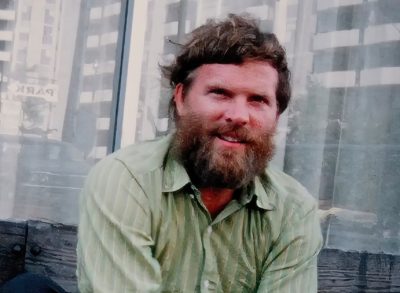
“Everybody wanted to go everywhere with Penny.” Molly Davis
Many know I’ve been a promoter/producer of concerts & events since I was a teenager — so I’m gonna love a story with a dream-driven gets-things-done promoter at its core. And anyone who’s ever been in any place I lived has seen John Lennon pictures everywhere. But what most don’t know is I consider D.A. Pennebaker one of the greatest artists who ever lived.
Penny was to film what Chuck Berry was to music.
Not only did he invent and set the high-bar standard for rock documentaries, he hand-built the cameras that connected to a recording source, and thus was one of the handful of people who invented cinéma vérité — from French, meaning “cinema truth” — also known as “direct cinema.” Part of my affinity and connection is — the books I write are cinéma vérité on the page — capturing what happens, then editing the sequences into a story. And Penny is a master of that on the screen.
![]()
Pennebaker with his homemade camera
and the coil cable to the Nagra tape recorder at his waist
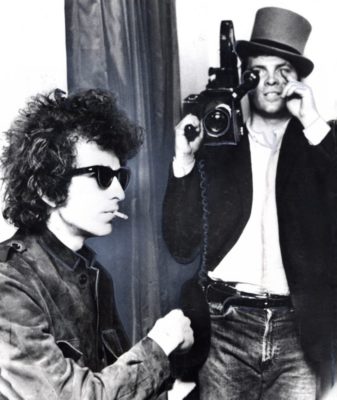
He got a degree at Yale in mechanical engineering and began his adulthood as an inventor/developer. By the early ’50s he’d become friends with the multi-disciplinary artist Frances Thompson in New York where he began building lenses, distortion devices and cameras for him, including collaborating on his groundbreaking masterpiece N.Y., N.Y., which was finally finished after 10 years of work in 1957. Thompson never told anybody how he did it, but D.A. Pennebaker was in the thick of it.
Not only did Aldous Huxley write about this film in Heaven and Hell, but when he saw an early screening in Thompson’s apartment, it was shown on Penny’s screen and with him as the DJ on the turntable providing the soundtrack. Can you imagine Pennebaker, Aldous Huxley and Francis Thompson all hanging in an apartment in Manhattan?! Penny cites his time spent with Thompson as when he changed his focus from being a mechanical engineer to a life an artist — just one more of the endless examples of that city in that time changing everything about every form of art. (see, also: “Abstract Expression: From Beat to Brando” about 1945 to ’55 in New York City, from The Rolling Stone Book of The Beats)
If you’ve never seen the 15 minute N.Y., N.Y. day-in-the-life masterpiece, stop reading this and watch it on the biggest screen you can right now! 😉
One other incredibly cool tidbit — Penny was coming of creative age in Manhattan at the same time as Jack Kerouac, and they actually met through The New School, and Jack tried to enlist him to make a movie of On The Road. (!) Penny had to explain to Jack that the only way he could do it was if he’d been next to him on the highway as it happened. But how extraordinary that these two artists who both revolutionized their mediums — and both created art out of capturing real life — overlapped as their revolutionary lives exploded like spiders across the stars over America.
Two huge supporting characters who are not mentioned in the new Revival ’69 doc are D.A.’s right-hand rock ‘n’ roll man Bobby Neuwirth; and the pioneer of remote recording, Wally Heider. Neuwirth and Penny first connected during the Don’t Look Back Dylan tour of England in ’65. When accepting his Lifetime Achievement Oscar in 2012, Penny said, “One person that was very instrumental in my education as a filmmaker was Bobby Neuwirth. He knew how to function in a group of people without disturbing them and yet watching what they really did, not what they pretended to do.” Bobby was Penny’s go-to guide at Monterey Pop, telling him which songs he needed to capture by each artist. And when the Toronto Revival came up two years later, the director wanted his rock n roll soulmate with him, so he brought him along as a cameraman, but I’m sure he was a lot more than that. In fact, I’d love to watch a 2-hour documentary on just what Bobby Neuwirth was up to that weekend! 😀

Neuwirth & Pennebaker at Monterey Pop, 1967
Wally Heider is not a household name, but he recorded a bunch of the albums in your collection — from the Grateful Dead to Van Morrison to Aretha Franklin. Just as Necessity Is The Mother of Invention that led Penny to invent a handheld camera with portable audio recording, Wally invented high-end remote music recording because nobody else was doing it. He started with Big Bands in the ’50s, and by ’64 was recording The Beatles at the Hollywood Bowl and Ray Charles at the Shrine. Thus, when Monterey Pop came along in ’67, he was the go-guy who recorded every pristine note you ever heard from there. As festival producer Lou Adler reflected later, “Wally Heider had the only remote in town — two complete sets of eight-tracks.” “And good mics,” D.A. chimed in. Once Penny was in for a pound on Toronto, he hired Wally to truck his gear across the country to secure solid live audio.

The Monterey Pop film came out in December ’68, and suddenly the rock concert film was ‘a thing’ — prompting every prospective festival promoter to want to have theirs filmed, and a lot of the calls went to Pennebaker’s office — but he felt he’d already made his rock festival film and wasn’t interested in repeating himself.
Then this call came in from some promoter in Toronto with the prospect of capturing the founding fathers of rock ‘n’ roll on a multi-camera shoot on a good stage with natural lighting — now, this was something that piqued Penny’s interest. As with nearly everything with this show, it happened last minute — just over a week before the gig — when John Lennon wasn’t even a glimmer in anybody’s eye.
Another cool karmic twist — silent 8mm film cameras had been around since the 1930s, but in 1965 Kodak came out with the Super-8 — with sound! For this show, with Penny’s new-found stature as a hit filmmaker, he charmed (Christgau’s word) Kodak into lending him a bunch of the new cameras, with one of the ideas being to give them to the musicians to shoot their own footage, thus furthering the idea of direct cinema — making the subject also one of the filmmakers in real time. Two hours of unprocessed Super-8 footage was found in Penny’s storage boxes. Besides all the backstage footage, there’s a great scene in Revival69 where Alice Cooper’s on stage with a Super-8 filming Pennebaker filming him with a 16mm! 🙂
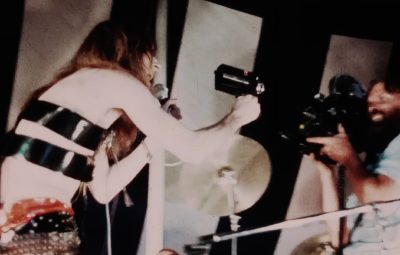
Jump-cut 50 years, and the spiritual grandson of Papa Penny, Ron Chapman, is paying respect with this film to his forefather just as John Lennon was there paying his respects. Chapman has been longtime friends with the Revival promoter, John Brower, who’d regaled him with the stories of the ’69 festival many times over the years. Brower had long been mulling ways to get this movie made, but as he shared on Bill King’s podcast, everything changed one night —
“It was at a New Year’s Eve party seven years ago at my place in Toronto. Everybody was shit-faced out of their mind, and Ron shows up a little after midnight and starts yelling at me — ‘You need to let me make this movie! You’re never going to get this movie made. You’ve been trying for three years — you’ll never do it.’ And I’m going, ‘Ron! Ron! Quiet, please!! Just be quiet! If you stop yelling, you can make the movie!’ And that was it. I gave him my story rights — ‘Just stop yelling, please!'” 😀
And that’s how Chapman, the director of a half-dozen prior music documentaries, finally took the reins and began to craft this visual story of musical history. As he told Welcome To The Music —
“I’m interested in doing Canadian stories of international significance. And I wanted to do this particular story because it’s just incredible. Rolling Stone called this ‘the second most important event in rock history.’ So you have to ask yourself — if this is the second most important event in rock history, and it happened in Toronto, and if it wasn’t for a Canadian, John Brower, this would never have happened. It’s the biggest rock story in Canada’s history — and nobody knows about it!“

Varsity Stadium, Toronto, Sept. 13th, 1969
And that’s one of the beautiful things about this film — the story. We’ve all seen a million rock doc concert films, from Wadleigh’s Woodstock to Scorsese’s Shine A Light, and in the main, they’re multi-hour live-performance music videos. What’s so refreshingly different here — perhaps inspired by the natural narrative spirit of D.A. Pennebaker — is that it’s the storytelling of the event that really sets this movie apart.
Director Chapman could have just grabbed a few talking heads to stick in between all the hall-of-fame performances, but instead enlisted his frequent collaborator and a filmmaker in her own right, Phyllis Ellis, to tell the complex story with more improbable twists than an Agatha Christie Knives Out thriller. Who’s going to believe that a 22-year-old kid in Toronto phoned Apple in London and got John Lennon to form a new band in 24 hours and fly across the Atlantic to perform at his festival? The local radio stations sure as hell didn’t believe him!
Besides the actual events of history, and the priceless live-action footage from the original King of Capture, what glues you to your seat is the storytelling.
I asked Ellis how the heck she did it.
“It’s an incredibly fertile story with so many detours. The real challenge at the beginning was the digging to lock down the Lennon story. Once we knew that was solid, we could rock ‘n’ roll. Once I can see the story — once the material starts talking back to me — I know I’m on a roll. Then it’s like a fast moving train — wrapping narrative around narrative, seeing them all in motion, and then finding the visual language to match the stories the characters tell.”
The storytelling has such a clear and cohesive arc, and it moves so smoothly, even with all these complex characters and almost unbelievable twists and chance events all happening ratta-tat-tat — so I asked her how she saw the straight road of the story amongst all the fireworks going off simultaneously in all directions.
“Massive discipline frankly; heavy, heavy lifting from transcripts, knowing what we wanted to achieve and committing fully. Not that there weren’t false starts and some pretty hilarious missteps, but that’s the process of writing anything. The more fulsome and fat you create a story, it’s so much easier to cut it down then breaking your brain to fill in something that isn’t there. I must say also, Ron’s concepts and visual approach with Mathew den Boer doing the animation really filled in the gaps narratively and we were thankful to have that other element.”

And, boy, animator den Boer created beautifully conceived, period-driven visuals that amplified key events and surfed the viewer back to 1969. As director Chapman pointed out, it was no less than The Beatles who pioneered animation to tell a rock ‘n’ roll story with Yellow Submarine.
I asked den Boer what drove him on this project —
“The main thing with the animated scenes was to make them feel continuous with the story. We needed a way to visualize moments that were not captured in footage while striking the right balance between reverence and playfulness. It was kind of heavy to be drawing these legendary figures, but it’s also a rock ‘n’ roll story and a bit of a caper. Ron created an atmosphere for some pretty wild exploration when we started out, and that eventually led to the hybrid of the illustration, photography and psychedelic graphic elements you see in the film.”
Another key reason this works so well is the film editing, in this case by Eugene Weis. Editors are rarely mentioned by name in film reviews, but so much of the audience’s experience stems from the choices they make. To play on Kenny Rogers, you have to know when to hold ’em, and know when to cut ’em. And what’s wonderful here is how editor Eugene has been careful with that axe, not only included the exposition, but a bunch of the comic asides and blooper moments a lot of other editors would have left on the floor. This is rock ‘n’ roll, not Wikipedia. This documentary manifests the playfulness, joy, chaos and kiss-ass confidence of everything rock has been from Chuck to John to Alice.
And before I get off the production riff — the score by Richard Pell and Pierre-Adrien Theo is sublime — used only when needed, but perfect when applied. Every note of this symphonic collaboration is perfectly in harmony.
And then there was the concert.
Besides the mastery of the filmmaking, this was one of those live shows that all concert-goers hope to be at. We’ve all attended hundreds or thousands of them, but there’s those rare few when everything comes together and all the performers are in the zone on the same night.
One of the afternoon lead-off bands was no less than Chicago Transit Authority, as they were known then before they shortened it to Chicago. Everybody’s familiar with their sound now, but with only one barely-charting single out by Sept. ’69, almost no one knew who they were, and here was this 7-piece jazz–soul–R&B–rock band with one of the great powerhouse tenors of all time, Peter Cetera, and a 3-piece horn section blasting out brass across the grass. If your body moved to music, this was the spark that ignited the day.
Robert Christgau, who was embedded with the Pennebaker crew writing a profile on him for Show magazine, described in detail how they had no signed rights release from the first main act, Bo Diddley — nor did they even have the cables plugged in or electric outlets available to film him. But mid-set, one of Penny’s business guys appeared with a last-minute signed release, so they jumped into action — running on barely-charged batteries with nobody in position. Miraculously, even though festival acts are never supposed to do encores, just as Janis did a second set at Monterey when Penny wasn’t allowed to film the first one, Bo came out for an unplanned encore, and by then Pennebaker’s team were in place and caught a classic, joyous, call-&-response Hey Bo Diddley for eternity. Penny gets so into it, his camera almost becomes an extension of the guitar. And Bo is positively testifying by the end — a male Aretha — taking the blaringly white Toronto audience to church.
And then — Killer phuckin kills!
One of the great things about the booking of this show (and John Lennon causing the stadium to be full) was that all these legends who invented the medium missed out playing to crowds this size. For the most part, by the mid-’60s they were in lounges and ballrooms … while the newspapers were full of pictures of young rock bands with audiences going back as far as the eye could see. What’s wonderful here is that every one of these nearly-forgotten giants seized the moment and laid down career-defining shows. And extraordinary point #2 — D.A. Pennebaker was there to capture it all!

Jerry Lee Lewis comes out wearing a plain brown turtleneck and slacks like these kids’ parents mighta bought after seeing in an Eaton’s catalog — and he blows up the idea that you couldn’t trust (or rock to) anyone over 30. ‘Dad’ is confident, in control, and like Bo Diddley, positively schools these kids in rock ‘n’ roll — all while rockin’ an instrument they’d only seen Liberace play on Ed Sullivan!
One of the most rewarding aspects of this and Pennebaker’s multiple Revival films is experiencing these guys performing to a real audience — not on a TV or film set — which is the only way most of us have ever seen them perform. But here they are, in color for one thing, and interacting with an exuberant and engaged audience. And to be completely confessional, it was watching Penny’s film of Jerry Lee’s set that I finally ‘got’ what his buzz was all about.
And then, The founding father of rock ‘n’ roll, Chuck Berry, kicks it up another notch.
Chuck aficionados say this is one of the best shows he ever played. All these old ’50s brothers were in the same place at the same time, and they were all damn-sure gonna be the one people walked away talking about! It’s so great they all got to have their moment in the (literal) sun of a beautiful September day — and with a great filmmaker capturing it.
Had these guys ever played full sets to full football stadiums? They were playing theaters at their peak. Then after those Moptops appeared on Sullivan and sold out Shea Stadium, and the baby-boomers came of age en masse, and the Summer of Love happened, and record stores started opening in every neighborhood in the land, well, these founding rockers missed all that and were left in the fifties with Bing Crosby and Doris Day. . . . But not on this day.
Chuck was swingin for the fences. And, being one of the greatest natural showmen in all rock history, he knew a moment to grab when he saw it. And boy, does he grab it.
Including grabbing some local cats hanging backstage to be his band!
It just so happens, a young jazz-fusion Toronto combo called Nucleus were one of the early opening acts and were hanging around backstage, when, without a moment’s notice, the bassist & drummer were enlisted to hold down the tracks that Chuck frickin Berry was gonna be rolling on! An historic day of music that bassist Hughie Leggat and 18-year-old drummer Danny Taylor were never gonna forget anyway — suddenly got kicked into the surreal!
Here’s D.A. capturing the kid on drums . . .

And here he is in 2022 after he retold me the whole story at the premiere afterparty a half-mile from the original venue . . .
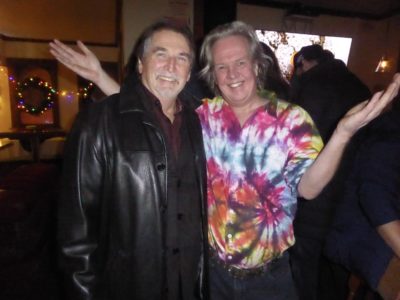
And here’s D.A.’s film of Chuck’s set — click on the photo below and it’ll open and play . . .
And THEN — as if this backup band story wasn’t wild enough! — young unknown Alice Cooper band backed up Gene Vincent! It’s true!
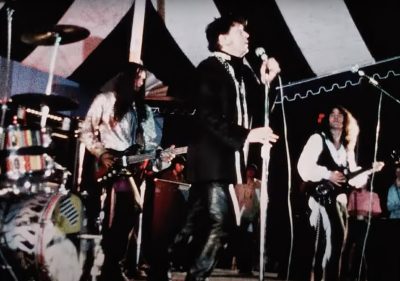
I’ve been an Alice Cooper fan since Billion Dollar Babies was the first rock album I ever bought, Christmas 1973 . . .

Yours unruly — Halloween ’75
Of course I knew he played at this Revival, but never knew until this movie that he & the band backed up Gene Vincent!
A few years after this concert, when John Lennon recorded his tribute album to the early rock ‘n’ roll songs that inspired & ignited his life (Rock n Roll, 1975) three of the songs he covered were played by the originals at this show — Chuck Berry’s Sweet Little Sixteen, Little Richard’s Rip It Up, and the song he chose to open the album — Gene Vincent’s Be-Bop-a-Lula. As John tells the story, the first time he sang this song in public was the day he met Paul, and it was so beloved by the band it remained in The Beatles’ live repertoire all through the early years. Fortunately, Pennebaker was on hand to capture its ‘revival,’ including when a bunch of the Vagabonds Motorcycle Club decided the stage was the best place for dancing and some wonderful rock ‘n’ roll chaos ensued — all with the appropriately unhinged Alice Cooper band playing through the mayhem.
And sorta surprisingly, Toronto’s Vagabonds ended up playing a big role in both the original event and the film. They leant the promoters the 25 grand to book The Doors, but more visually wonderful was how they organized 80 bikes to be the motorcade for John Lennon from the airport to the venue on the day of the show! Penny immediately saw the cinematic possibilities, and sent young Molly Davis & others out to accompany them, armed with the new super-cool Super-8 cameras! Not only do they get tons of wild footage both on bikes and off, but somehow Penny managed to place cameras along the route so we see this comical motorcade of leather-clad bikers escorting white-suited peacenik John Lennon & company riding in cartoonish old-timey black stretch limos that look like the prototype for the Batmobile!
And then “the ninth wonder of the world” Alice Cooper hit the stage — in the early spectacle daze when they were still signed to Frank Zappa’s appropriately named Bizarre Records and who couldn’t find a hit song if they stumbled over it. In fact, it would be a 19-year-old aspiring record producer in Toronto named Bob Ezrin who, a year later, would take on the Coop and whip them into a cohesive recording band that then produced a nonstop string of hit singles and albums through the ’70s. Alice called Ezrin “our George Martin,” and just as the producer of this concert changed the course of Beatle history, a different young Toronto producer changed the course of theatrical shock rock.
This was also the show where Alice famously threw a live chicken into the audience. “It seemed, in the mayhem,” he remembers, ” … it had wings, it should fly. … But chickens don’t so much fly as they plummet.” — which led to headlines all over the world about Alice Cooper biting the head off a live chicken. Zappa wisely advised them to not refute any of the accusations, and the band got the most press in their career to that point! Their legendary manager Shep Gordon confesses here on camera for the first time that it was he who put the chicken on stage, and added, from a 21st century distance, “That moment lit the path for the next 25 years of his career.”
And boy, between Alice and Yoko’s performances, the audience that day sure got exposed to some pretty wild avant-garde music!
Here’s 13 minutes of Coop’s set via D.A. Pennebaker’s cameras —
Although the show’s operating motivation was for everybody to try and top everybody else, Little Richard practiced that with every gig he ever played! He had the stage lights turned off so there was just one spotlight on him in his mirrored vest — which he showed off dancing on top of the piano for much of his set. During this period, he had another guy playing Little Richard-style grand piano, while the original went out front and did a Tina Turner routine.
30 years after this Toronto show, I saw him perform up close in a small room in New York during the MTV daze, and he still had this same energy, chops and showmanship at age 70.
Here’s D.A. Pennebaker’s joy-jumpin’ Little Richard: Keep On Rockin’ 28-minute film of the Toronto set. As Doors guitarist Robbie Krieger recalls in Revival69 — “I was standing with Jim, and he goes, ‘Man! We gotta follow that?!‘” 😀
The John Lennon set is of course historic and the reason there’s a movie about this concert. And it never would have happened . . .
If the promoters hadn’t booked Chuck Berry at the Pop Festival in June.
If Chuck hadn’t positively slayed on stage that day.
If John Brower hadn’t caught his set.
If he & Ken Walker hadn’t hatched the idea to do a ’50s show.
If all the ’50s performers had not all been available on the same day.
If the Revival had advance sales of 20,000 … instead of 2,000.
If their rock journalist pal Ritchie Yorke hadn’t talked them into bringing in Kim Fowley from L.A.
If Fowley hadn’t insisted on Brower calling John Lennon.
If Lennon had been recording or out of town.
If Ritchie Yorke hadn’t have been hanging around Apple at the time to vouch for Brower.
And nobody in Toronto would have believed John was coming if he hadn’t have done a quick press gaggle at Heathrow on the way out of town.
Young future Yes (and Lennon solo) drummer Alan White (20 years old at the time) didn’t believe it was John calling to recruit him, and Lennon had to ring back a second time to convince him.
The number of crazy improbable events that all had to happen in the 48 hours prior to this show may be the single greatest streak of jackpot wins in the history of rock ‘n’ roll.
Those of us of a certain age all had that blue-sky-covered Live Peace in Toronto in our record collections — it being the only live album of a solo Beatle playing rock ‘n’ roll on a stage — but the backstory was never well documented until now.
The band was put together in an afternoon — worked up a set list on the plane on the way over — and had one quasi rehearsal through a single amp in a cinder-block football players’ dressing room.
Mal Evans, The Beatles’ invaluable ever-present all-purpose roadie, made the trip to make the staging happen, and noted how they set up like the Fab Four always had with the bass on audience left, the lead guitar in the center, and John where he always was on the right.
A 16-year-old Geddy Lee was there blazing on some “Owsley Purple Haze,” as he told us at the premiere Q&A.

Canadian music historian Alan Cross moderates a post-screening talk with Rush’s Geddy Lee and director Ron Chapman, with The Doors’ Robbie Krieger and promoter John Brower Zooming in.
Geddy described the moment: “The light shining from John Lennon left you with your jaw dropped. He was a Beatle, and that had an aura about it, and imbued everyone with a kind of awe — the fact that we were in the same vicinity as him and he was playing for us!”
For Lennon’s first-ever post-Beatles live show, they got themselves grounded on stage and kept the theme of the festival going by playing three rock ‘n’ roll classics the band all knew — Carl Perkins’ Blue Suede Shoes . . . about which Mal Evans shared — “I remember turning around on stage during the band’s performance and finding Gene Vincent next to me with tears rolling down his cheeks, saying, ‘It’s marvelous. It’s fantastic, man.'”
And then the Motown hit Money that The Beatles rocked live regularly circa 1962–63 . . .
and the Dizzy Miss Lizzy cover that the Fabs played since their earliest days, recorded for the Help! sessions, and was part of their live repertoire through ’65. These last two were always Lennon lead vocals which he clearly felt comfortable with and show why he’s one of rock’s great male vocalists.
Then things really got interesting — the only Beatles song they’d play all night — Yer Blues — the heart-wrenching John song (“I’m lonely, want to die”) from the White Album. This was also Lennon’s go-to when he appeared in another one-off band he put together a year earlier, The Dirty Mac, for The Rolling Stones’ Rock ‘n’ Roll Circus, in December ’68. Although John technically played that show without The Beatles (with Clapton, Keith Richards on bass and Jimi’s Mitch Mitchell on drums) it was on a soundstage for a TV show with only a few invited friends as an audience — not a paying crowd of 20,000.
And then homie drops the first version anybody ever heard of Cold Turkey! It was so new that Yoko had to hold up the lyrics on a sheet of paper in front of him!
This song was recorded 5 times. It debuted in Toronto on Sept. 13th; then was recorded in Abbey Road two weeks after this show with Eric, Klaus & Ringo; and he played it once in both the afternoon and evening One To One concerts at Madison Square Garden on Aug. 30th, 1972; but the hair-raising bone-chilling shiver-inducing definitive version was live at the Lyceum Ballroom in London for a UNISEF benefit on Dec 15, 1969, and was included on the live disc with Some Time In New York City. The last three minutes of the withdrawal are insane. It’s the original Toronto Plastic Ono Band reunited, plus George Harrison (who arrived with Eric, Delaney & Bonnie), and would be the last time John would share a stage with a Beatle; Keith Moon joins in banging on Alan White’s toms; Billy Preston’s on the keys; Bobby Keys is on the preston … I mean the sax; with Delaney & Bonnie on guitar and tambourine. The song was written about quitting heroin — but I wonder if some of the subtext angst was also about quitting The Beatles?
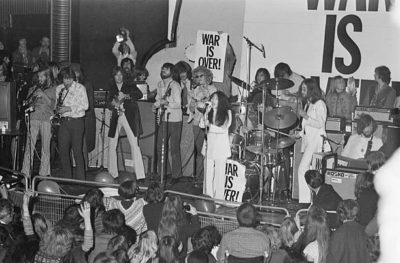
And then of course John climaxes with Give Peace A Chance. “This is what we came for, really,” he says, before doing a live version of the hit song he recorded in a Montreal hotel room three months earlier.
John & Yoko had first flown to Toronto back in May to do their second bed-in for peace (following Amsterdam in March), and it’s where 14-year-old Jerry Levitan met and interviewed them, which became the I Met The Walrus book and DVD.
Their week-long bed-in for peace in Montreal (following their short stay in Toronto) was when they hung with Allen Ginsberg, Timothy Leary, Dick Gregory, Tommy Smothers and a bunch of other voices for cultural change and recorded Give Peace A Chance in their pajamas.
Shortly after the Revival concert, in December ’69, John & Yoko flew back to Toronto to launch their “War Is Over! If you want it.” campaign that included billboards being put in a dozen major cities around the world. This is also when they went and stayed at Ronnie Hawkins’ ranch, which would make a whole other great documentary!
Canada played a pretty big role in John Lennon’s life, and you can read about all the Beatle–Canada connections in John Arnone’s excellently written, deeply researched and highly recommended book Us and Them: Canada, Canadians and The Beatles.
Here’s The Plastic Ono Band’s entire set via D.A. Pennebaker —
The Rock ‘n’ Roll Revival ended with The Doors, who, like some artists back then, were suspicious of people filming them, and never signed a release, so Penny & his crew packed up early. But good ol’ Wally Heider got the audio, and one of the last things you hear in Revival69 is Jim Morrison saying from the stage —
“I can remember when rock ‘n’ roll first came on the scene, and for me it was a very liberating experience, because it opened whole new strange catacombs of wisdom that I didn’t know about and I couldn’t see any equivalent for in my surroundings. And that’s why for me this evening it’s been a really great honor to perform on the same stage with so many illustrious musical geniuses.”
You can see the beautifully assembled 97-minute Revival69 film of this whole improbable story starting in February 2023 on Crave in Canada, and coming soon to the rest of the world.

With director Ron Chapman at the premiere afterparty —
a half-mile along Bloor Street from where the concert happened
======================================
Here’s the 2-minute trailer for Revival69 . . .
This new doc is the natural sequel to Peter Jackson’s 2021 Emmy-sweeping masterpiece The Beatles: Get Back — picking up the story seven months later. Both were made from 1969 film footage preserved in storage but untapped for 50 years. Both were digitally upscaled to 4K and the audio completely remastered. Both feature new songs the audience hears shortly after they were written, and classic rock ‘n’ roll covers that the band was born out of. Both show John & Yoko as inseparable and in love, and both feature live outdoor performances. If you haven’t seen the Revival69 prequel, you need to. Streaming on DisneyPlus.
And if you love great documentaries about historic music festivals that were overlooked at the time but were in fact captured by multi-camera professional crews, you gotta see Summer of Soul, about the Harlem Cultural Festival. Both festivals took place in 1969 in the largest city in their country (Toronto and New York), featuring the founding giants of their musical idioms, and both had the original footage sitting untapped in storage boxes for decades. It won the Best Documentary Oscar and tons of other awards, and features live performances by Mahalia Jackson, Nina Simone, the Staple Singers, B.B. King, Stevie Wonder, Gladys Knight, Sly & The Family Stone, Max Roach, Hugh Masekela, The Chambers Brothers and many others. Also streaming on DisneyPlus.
================================
Some other pages you might enjoy —
The promoters were bringing giants of the past into the present, including those who changed the world forever starting in the 1950s, and that’s something I’ve also been doing with my work — bringing Jack Kerouac and the Beats into the present day. I’ve written several books on the matter, but The Hitchhiker’s Guide to Jack Kerouac is particularly to the point.
Here’s a fun, informative, rollicking Welcome To The Music podcast featuring promoter Brower and director Chapman —
Here’s a great Toronto Star feature on the film.
Here’s director Ron Chapman’s concise statement on what drove him while making the film.
Here’s Mal Evans’ 1969 account of the Revival trip and show.
Here’s D.A. Pennebaker’s full Rock ‘n’ Roll Revival documentary Sweet Toronto —
And here’s Penny’s brilliant & beautiful first real film Daybreak Express made between 1953 and 1957 — an impressionistic take on life in New York City at that time, with a Duke Ellington soundtrack . . .
And here’s where Best Documentary Oscar winner Michael Moore presents Penny with an honorary Lifetime Achievement Oscar. “Pennebaker did two very simple things. First, he took the camera off the tripod! That’s it. In that one moment when Penny unscrewed the camera from its stationary position, the world of filmmaking changed — nonfiction and fiction. Second, Pennebaker and his friends invented the first portable synched sound mechanism where the 16mm camera could move, and sound would be in synch with it. He invented this apparatus back in the ’50s and it changed everything for filmmakers, regardless of what kind of films they wanted to make — cuz sound could now match the picture.”
==========================================
And in the spirit of this festival of riches, you might also enjoy . . .
The Beatles: Get Back — annotated and time-coded — something I put together last year and people are still reading every single day.
Here’s a great piece that connects the Beatles and the Beats via Michael McClure’s The Beard.
I was in Manhattan the night John was killed. It took decades before I could revisit it, but I finally did.
I also saw Festival Express at its premiere in Toronto — the other great Canadian rock festival documentary, produced by Ken Walker the co-promoter of the Rock ‘n’ Roll Revival — and I ended up writing the feature story on it for Relix.
In fact, there’s a whole Movie category on my website that’s got dozens of film stories.
Including the unknown gem My Dinner with Jimi — which is set in 1967 and premiered at this same Hot Docs theater, and I got to spend some time afterwards with the funny raconteur creator Howard Kaylan.
And in fact The Wrecking Crew movie premiere was also at the same place!
And speaking of premieres — here’s On The Road outdoors in London.
And here’s the amazing tale of its premiere at TIFF in Toronto where I began my friendship with director Walter Salles.
And here’s the wild New York premiere story.
==============================
by Brian Hassett
karmacoupon@gmail.com — BrianHassett.com
Or here’s my Facebook page if you wanna join in there —




14 responses so far ↓
1 Dale Topham // Jan 1, 2023 at 4:46 PM
This piece is fantastic, In your own inimitable way! I read the text, will come back and check out the videos. I love how this has all the details and components of the show from every angle!
btw “That Thing You Do” walked up my driveway this morning!
2 Holly George-Warren // Jan 1, 2023 at 10:40 PM
Fantastic article, Brian! Thanks for the detective work and the great play-by-play! I can’t wait to see the film!
3 John Robert Arnone // Jan 2, 2023 at 7:59 AM
This is so typically Brian — depth, detail, heart and soul like nobody’s business! By far the most thorough and interesting piece ever written about “Canada’s Woodstock”! Well done Brian.
You have the makings of a book here. This was Lennon’s second of three remarkable visits to Canada in 1969 and the first time he played to a stadium crowd without his Liverpool wingmen.
And thank you very much for the book plug — I wasn’t expecting that. Cheers bro.
4 Ted Lindsay // Jan 4, 2023 at 2:13 PM
This is an epic masterpiece. Just awesome!
Your list of ‘IFs’ that made this happen present it like a musical ‘Big Bang.’
5 Will Hodgson // Jan 5, 2023 at 11:24 PM
Hey, man! I love this whole thing, and what really makes it pop are all the various links …. NY,NY, Chuck’s set, Jerry Lee’s set, Cold Turkey, etc … pretty cool. Articles can be so 3-dimensional nowadays when you add the links.
Thanks for looping me in.
6 Allan Robinson // Jan 9, 2023 at 8:16 AM
Great article, I can’t wait to see the film in the states. As always, your articles are well researched and filled with the joy of the experience.
7 Jim Nystrom // Jan 11, 2023 at 9:29 PM
Wow! Double WOW!
You can Not make up
Something this Great.
Thanks for bringing it all back home.
8 Brian Callahan // Jan 11, 2023 at 11:31 PM
Put it on Crave already! Please.
9 Jennifer Knox // Jan 14, 2023 at 10:08 PM
Nice to see your movies and music loves coming together once again. You always take me on “a trip.” … usually back in time to a happy place. Thanks for another great ride and hope to see you somewhere in 2023.
10 Joan Driscoll // Jan 15, 2023 at 8:18 PM
Thanks for this. Can’t wait to see it. When’s it going to be available in the States?
11 Brian // Jan 15, 2023 at 9:11 PM
Hey Joan! That I don’t know. A producer told me they were working on it, so that’s kinda all I know. But with the popularity of both “Get Back” and “Summer of Soul” I gotta figure there’s gonna be an open door down there before long. 😉
12 Scott Moore // Jan 16, 2023 at 1:17 AM
Great piece and music. Really enjoyed it. Thanks.
13 Dean McClain // Jan 16, 2023 at 2:19 PM
Wow, Brian! What a piece!!!
14 Gordon Phinn // Mar 19, 2023 at 6:28 PM
Thanks for writing this fascinating and deeply informative article, Brian.
The Huxley reference rather blew my mind, I must say.
Your enthusiasm is infectious.
You are obviously an independent and knowledgeable voice.
Leave a Comment